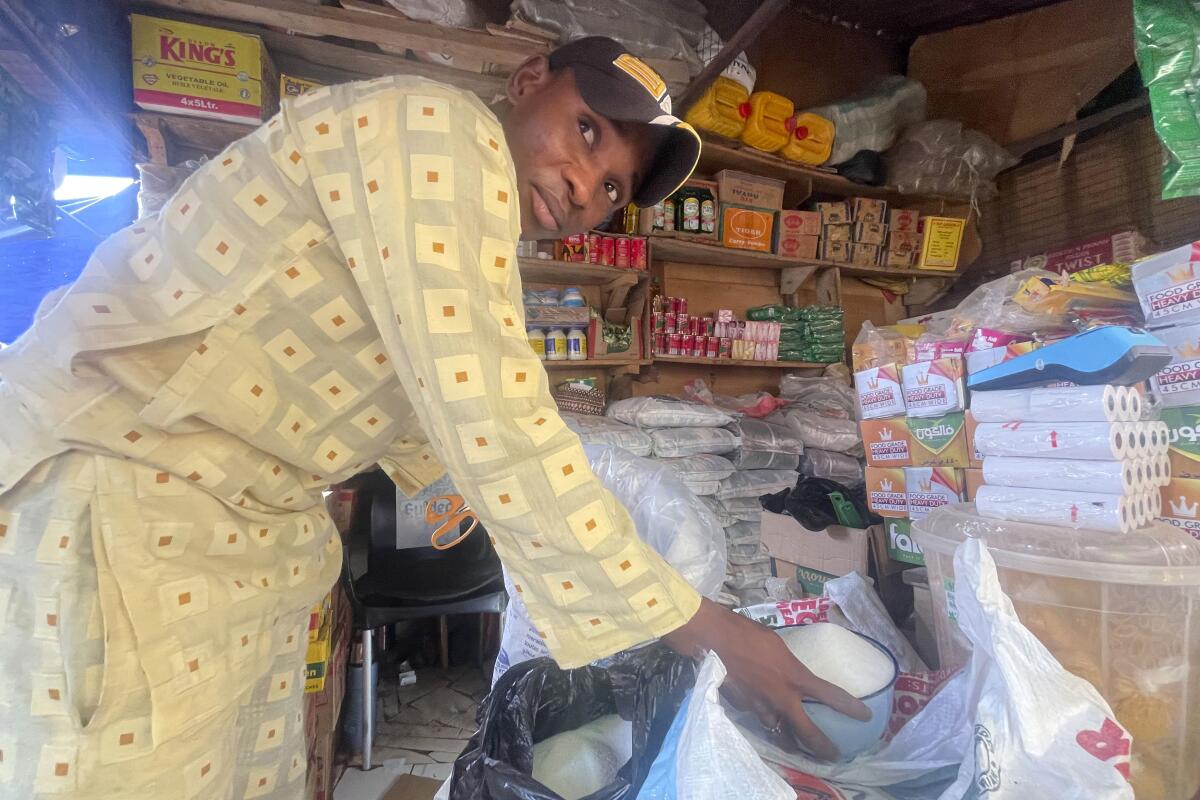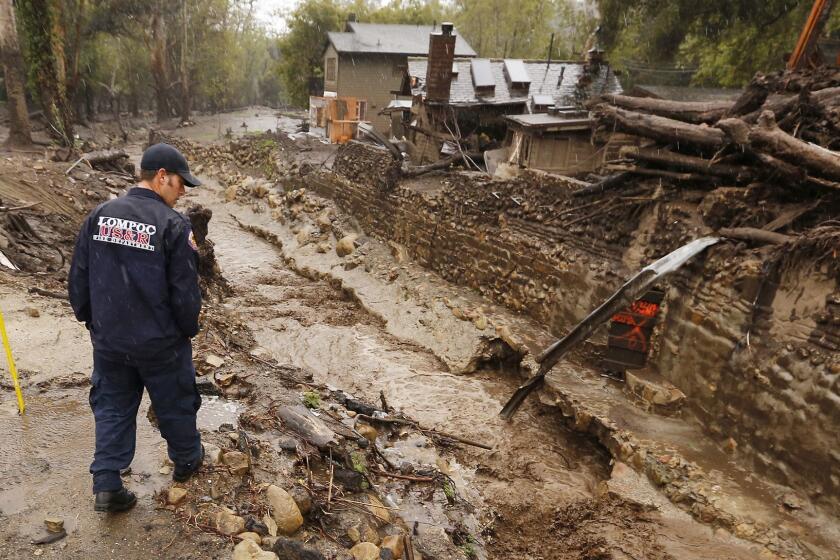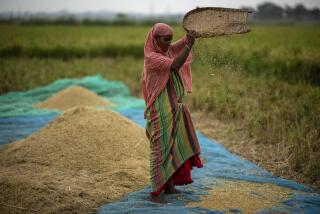Sugar prices are rising worldwide after El Niño-linked weather damaged crops in Asia

- Share via
Skyrocketing sugar prices left Ishaq Abdulraheem with few choices. Increasing the cost of bread would mean declining sales, so the Nigerian baker decided to cut his production by half.
For scores of other bakers struggling to stay afloat while enduring higher costs for fuel and flour, the stratospheric sugar prices proved to be the last straw, and they closed for good.
Sugar is needed to make bread, which is a staple for Nigeria’s 210 million people, and for many who are struggling to put food on the table, it offers a cheap source of calories. Surging sugar prices — an increase of 55% in two months — means fewer bakers and less bread.
“It is a very serious situation,” Abdulraheem said.
Sugar worldwide is trading at the highest prices since 2011, mainly due to lower global supplies after unusually dry weather damaged harvests in India and Thailand, the world’s second- and third-largest exporters.
This is just the latest hit for developing nations already coping with shortages in staples such as rice and trade bans that have added to food inflation. All of it contributes to food insecurity because of the combined effects of the naturally occurring climate phenomenon El Niño, the war in Ukraine and weaker currencies. Wealthier Western nations can absorb the higher costs, but poorer nations are struggling.
A strong El Niño could augur yet another wet winter for California, as well as drive the global average temperature to a record high, experts say.
The United Nations Food and Agriculture Organization is predicting a 2% decline in global sugar production in the 2023-24 season, compared with the previous year, translating to a loss of about 3.8 million U.S. tons, said Fabio Palmeri, an FAO global commodities market researcher. Increasingly, sugar is being used for biofuels like ethanol, so global reserves of sugar are at their lowest since 2009.
Brazil is the biggest sugar exporter, but its harvest will only help plug gaps later in 2024. Until then, import-dependent countries — such as most of those in sub-Saharan Africa — remain vulnerable.
Nigeria, for instance, buys 98% of its raw sugar from other countries. In 2021, it banned imports of refined sugar that ran counter to a plan to build up domestic sugar processing and announced a $73-million project to expand sugar infrastructure. But those are longer-term strategies. Abuja traders including Abba Usman are facing problems now.
The same 110-pound bag of sugar that Usman bought a week ago for $66 now costs $81. As prices rise, his customers are dwindling.
“The price keeps increasing every day, and we don’t know why,” Usman said.
It’s partly due to El Niño, a natural phenomenon that shifts global weather patterns and can cause extreme weather conditions ranging from drought to flooding. Scientists believe climate change is making El Niño stronger.
An El Niño that is among the strongest on record is gaining strength in the Pacific Ocean, and climate scientists say California is likely to face a wet winter.
India endured its driest August in more than a century, and crops in the western state of Maharashtra, which accounts for more than a third of its sugarcane production, were stunted during the crucial growing phase.
India’s sugar production is likely to decline by 8% this year, according to the Indian Sugar Mills Assn. The world’s most populous nation is also the biggest consumer of sugar and is now restricting such exports.
In Thailand, El Niño effects early in the growing season altered not just the quantity but also the quality of the harvest, said Naradhip Anantasuk, leader of the Thailand Sugar Planters Assn. He expects only 76 million metric tons (84 million U.S. tons) of sugarcane to be milled in the 2024 harvest season, compared with 93 million metric tons (103 million U.S. tons) this year.
A report by U.S. Department of Agriculture predicted a 15% dip in Thailand’s output in October.
Thailand reversed a hike in sugar prices within days, imposing price controls for the first time since 2018. Anantasuk said this would discourage farmers from growing sugar by capping their income.
“It’s like preventing the industry from growing, preventing an open competition,” he said.
Wholesale prices had been allowed to rise to help farmers cope with higher costs — partly due to government demands that they not burn their fields, which makes harvesting cheaper but envelops much of Thailand in heavy smog.
California is no stranger to extreme weather.
Looking ahead, Brazil’s harvest is forecast to be 20% bigger than last year’s, said Kelly Goughary, a senior research analyst at the agriculture data and analytics firm Gro Intelligence. But since the country is in the Southern Hemisphere, the boost to global supplies won’t come until March.
This is because of favorable weather this year in Brazil, along with an increase in areas where sugarcane was planted, according to the USDA.
The next few months are the greatest concern, said the FAO’s Palmeri. Population growth and rising sugar consumption will further strain sugar reserves, he said.
The world now has less than 68 days of sugar in stockpiles to meet its needs, compared with 106 days when they began declining in 2020, according to data from the USDA.
“It’s at the lowest levels since 2010,” said Joseph Glauber, senior research fellow at the International Food Policy Research Institute.
Indonesia — the biggest sugar importer last year, according to the USDA — has cut back on imports and China, the No. 2 importer, was forced to release sugar from its stocks to offset high prices domestically for the first time in six years, Palmeri said.
For some countries, importing more expensive sugar eats up reserves of foreign currency like dollars and euros that also are needed to pay for oil and other crucial commodities, said El Mamoun Amrouk, an FAO economist.
El Niño may not have brought much rain to Southern California, but it did take its toll on the Golden State’s beaches.
That includes Kenya. Once self-sufficient in sugar, it now imports 110,000 U.S. tons a year from a regional trade bloc. In 2021, the government limited imports to protect local farmers from foreign competition, but it reversed that decision as harvests shrank due to insufficient rain and mismanagement.
The amount of sugar milled in Kenya fell steadily from June to August. To compensate, monthly imports doubled from September to October. Meanwhile, a 110-pound bag of local sugar doubled in price to $60, shopkeeper Joseph Kuraru said.
Back in Africa’s largest economy, the struggle of Nigerian bakers is a microcosm of the effects of rising food and fuel costs and the outsized impact of high sugar prices because it’s so ubiquitous. Abuja’s many bakeries use sugar both to sweeten cakes and to feed the yeast that makes bread rise.
Bread is often the only food poor households can afford. When bakers raise bread prices, as they did by 15% earlier this year, some people go hungry.
Not passing along higher costs is not an option, said Mansur Umar, president of the Nigerian bakers association.
“There is no way you can buy high and you sell low,” he said.
Ghosal reported from Hanoi and Asadu from Abuja. AP journalists Jintamas Saksornchai in Bangkok, Evelyne Musambi in Nairobi and Courtney Bonnell in London contributed to this report.
More to Read
Sign up for Essential California
The most important California stories and recommendations in your inbox every morning.
You may occasionally receive promotional content from the Los Angeles Times.












